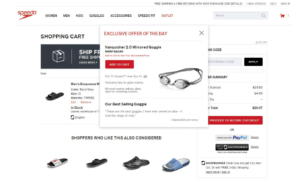Up-sell and cross-sell are two powerful strategies for increasing customer lifetime value. Up-selling encourages customers to purchase upgrades or extras, while cross-selling promotes complementary products that work together seamlessly. Utilizing these tactics can help businesses maximize their sales potential and enhance the overall shopping experience of their customers!
For sustained success, retailers should focus on developing effortless departmental efficiencies and tailored marketing strategies are driven by data insights. In particular, boosting profits and growing customer loyalty can be achieved by offering products that enhance the shopping experience with creative cross-sells or upsells—essentially increasing order value without additional costs to your business.
What is upselling?
Up-selling encourages a customer to purchase an improved or more expensive product version. It occurs when a customer tries to buy a basic product model and you highlight the benefits of a more sophisticated model.
Consider a theater.
It’s possible to stroll up to the box office and buy tickets for the basic theater, but it’s also possible that they have an upgraded theater with roomier seats and a more engaging experience. Instead, the theater might attempt to sell you these improved seats.
If you exchange your tickets, they’ve been able to sell you more. In this case, except for the movie tickets you originally intended to purchase, you did not get any more goods.
It’s possible to stroll up to the box office and buy tickets for the basic theater, but it’s also possible that they have an upgraded theater with roomier seats and a more engaging experience. Instead, the theater might attempt to sell you these improved seats. If you exchange your tickets, they’ve been able to sell you more.

In this case, except for the movie tickets you originally intended to purchase, you did not get any more goods. You still possess those tickets, but thanks to the upgrade, both the movie theater and you benefited from a higher order value.
What is cross-selling?
Cross-selling, on the other hand, pushes extra products that go together with the one the customer is about to purchase. The buyer purchases the original product together with one or more complimentary products as a consequence of a successful cross-sell.
Let’s go back to the example of the movie theater. The theater may try to up-sell you a reusable drink cup and popcorn pail as you purchase your tickets. They have effectively cross-sold to you if you buy these things along with your tickets.
Unlike the up-selling scenario, you did wind up with more things even if your original tickets remained the same. These complementing goods are still useful; you can now watch a movie while snacking on some buttery popcorn and sipping a soda.

How can cross-selling/ Up-Selling enhance customer experiences and increase revenues?
Online shopping has revolutionized customer expectations – they expect to find exactly what they need with only a few simple clicks. In order to provide this level of convenience, retailers must carefully tailor their offerings and integrate search history and preferences into product selection.
By leveraging these tools for customers’ benefit, both shoppers and retailers are rewarded through quicker browsing times that result in increased sales satisfaction!
How does PIM enable Cross-Selling?
Retailers and marketplaces can sell collections of related products thanks to PIM. They are grouped together based on shared characteristics, encouraging cross-selling and up-selling. For breakfast, a consumer buying cornflakes might also prefer to purchase milk, a cereal bowl, and yogurt.
A PIM system aids businesses in formulating rules that specify when and which goods should be recommended in relation to an item that a client has browsed. Based on the established principles, the PIM system will make milk, bowl, and yogurt suggestion to this consumer.
PIM solutions benefits
Implementing product information management by means of a central PIM system has many advantages. These can be found in both strategic and tactical and operational areas. The PIM system can therefore form a necessary condition for the continuity of your organization.
- Support buying process
- More sales
- Higher customer satisfaction
- The broader and deeper product range
- More efficient internal processes
In a world where customer experience is key, product content must be accurate, consistent, and easily accessible. A PIM system can act as your organization’s foundation for delivering high-quality product information to meet the needs of modern consumers. With a PIM in place, you’ll be well on your way to providing an exceptional customer experience that sets you apart from the competition.
Want to learn more about PIM?
If you have any questions regarding Product Information Management, from PIM Selection to Implementation or how a PIM would fit in your IT landscape? Feel free to browse our Knowledge Base of articles on everything PIM related.
Visit our Knowledge Base

